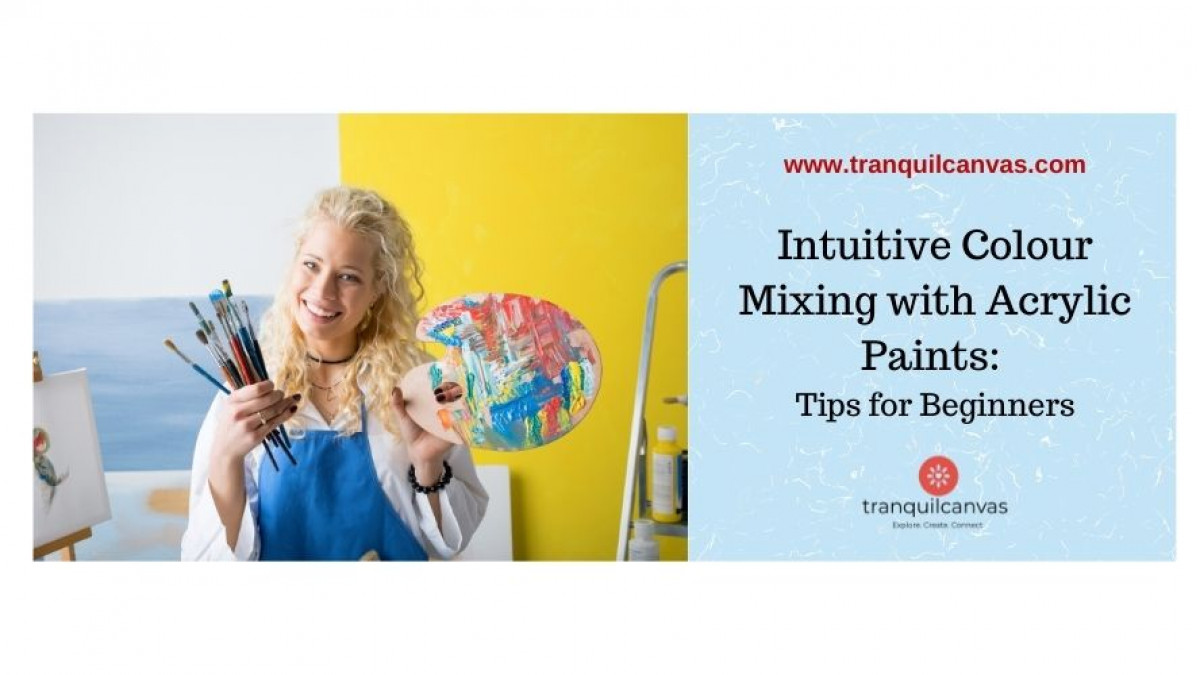Intuitive Colour Mixing with Acrylic Paints: Tips for Beginners

It is one of the most popular techniques because it allows artists to explore their creativity, have fun creating new colours and colour matches.
Intuitive Colour Mixing with Acrylic Paints: Tips for Beginners

Introduction: What is Intuitive Colour Mixing?
Intuitive colour mixing is when you mix colours together without any scientific or technical knowledge of what you are doing. However, for many intuitive artists or beginners, not understanding colour mixing basics and colour theory rules can result in a muddy mess and feelings of frustration.
Colour theory can help us understand how colours work together in harmony and what colours are complementary or opposite each other which can help when we are trying to mix paints intuitively.
The colour wheel is a great tool because you can use it as a guide for what colours should go together and what colours should not be mixed. And if you prefer a bit of structure to refer to then you might want to keep this handy while you embark upon intuitive color mixing journey :).
The technique is based on understanding that 3 primaries mix to form neutrals or earthy tones. This mix when unintentional causes muddy paintings. And once you apply this understanding to color mixing, you set yourself free to discover your own color recipes and have fun while doing so.
This method relies on intuition and the rules of colour mixing, which are set out in the colour wheel. The artist mixes two or three primary colours together to create secondary and tertiary colours, with an attitude of play and experimentation to create more colours.
The first step is to understand basics of color mixing and remember what primary colours are to avoid unintentional muddy paintings. The three primary colours are red, yellow, and blue. These three colours can be mixed in any combination to create secondary or tertiary colours. Additionally, white and balck colours when added to the process enable the creation of variety of tonal values and unexpected color-mixes which is the key benefit of exploring colours this way.

Tips for Beginners on Intuitive Colour Mixing with Acrylic Paints
A lot of people think that intuition is just a hunch, but it's a lot more than that. Intuition is the ability to understand something without being told. It comes from experience and training and can be improved through practice.
In this article, I will give you some tips on how to paint intuitively with acrylic paints.
One of the things that color theory shows us, is a way of understanding the different mixed colours, and how they can be created by combining two or more primary colours. For intuitive colour mixing process to work you simply need to remember the basics of colour theory to have more of ‘happy accidents’ as artist Bob Ross would have said and less muddy puddles.
- Experiment with different colours and different mediums. It can be easy for beginners to get stuck in a rut of using the same colours and materials all the time, but this will not help them grow or develop their skills.
- Always, ALWAYS create colour swatches while mixing colors and note recipes that you might want to replicate later. If this interferes with your ‘flow’ then simply use your mobile to capture a video of the process to refer when you need to :)!
- Start with a palette of basic colours and add black, white, or grey to create new shades.
- Mixing two complementary colours together will result in a third colour that can be again mixed with white, black or other primaries in varying proportions to create infinite color mixing recipes.
- When mixing colours, add colours gradually to study the color changes evolve which means you are creating many tones and hues as you go IF you add too much to start with, then it’s harder to retrace steps and you don’t discover as much as you would by adding small quantities.
Here is a more detailed guide on: The 2 minute Guide to getting started with intuitive colour mixing using acrylic paints

Conclusion: Why intuitive colour mixing method is great for beginners
There are many ways to paint, but it is important to find a technique that suits you. Intuitive Colour Mixing Technique is one of the most popular techniques used by artists because it allows them to explore their creativity and have fun while developing their skills.
Mixing colours intuitively is a great way to start painting, and it can lead to some beautiful results. The beauty of this technique is that you are not limited by any rules or formulas. You can just experiment with different combinations of colours and see what happens. You don't need to be an expert in art or painting to use this method, but it does help if you apply basics of colour theory and follow the rules of colour mixing. This makes it a fun and easy technique for beginners to learn about colour mixing in a stress-free way.
Still thinking about trying out one of our fun mixed media courses and still on the fence then read this : How are courses enable you to jumpstart your creative journey?
Categories: : Beginners Guide, Colour Mixing, Tips and techniques

 Soma Datta
Soma Datta 